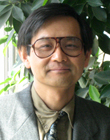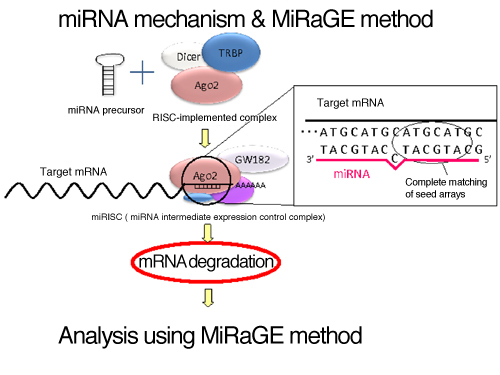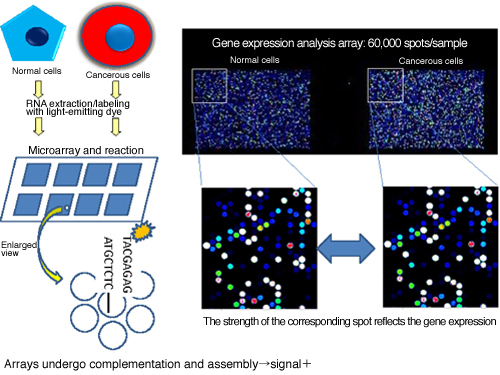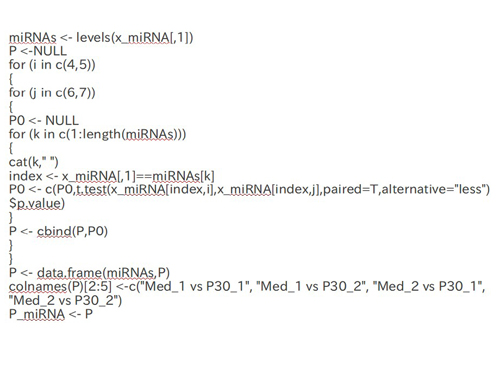Top>Research>Cancer research starting from Twitter
 Index
Index

Yoshihiro Taguchi [Profile]
Education Course
Cancer research starting from Twitter
Yoshihiro Taguchi
Professor of General Property Science and Bioinformatics/life science, Faculty of Science and Engineering, Chuo University
Cancer-a diseases which takes the lives of 1 in every 3 Japanese
Cancer is a disease which actually accounts for one-third of the causes of death among Japanese people. For that very reason, it is a disease for which fundamental treatment is sought to the extent that a research center has been established solely to confront cancer. I am a physics professor and my area of expertise is computational physics. Normally, my work would be significantly removed from areas such as cancer research. In this article, I would like to introduce how an unexpected turn of events led to my involvement with other researchers focusing on cancer.

From March 2009, the author spent 1 year at the European Bioinformatics Institute (EBI). The institute is located on the Genome Campus which is in the suburbs of Cambridge, England, a Mecca for bioinformatics. The institute is a world-class research facility for the field of bioinformatics.
The direct impetus for my involvement in cancer research was the year that I spent at a research center outside of Cambridge, England as part of a sabbatical (a break to focus on research). Since about 10 years ago, I have been interested in bioinformatics, a field which uses the strengths of information science to research the genome science which has made remarkable progress in recent years. During my sabbatical, I met researchers who play a leading role in advanced researches. However, all of the researchers operated their own laboratories and produced research results by analyzing experimental data gained from those laboratories. I am nothing more than a theoretical physicist and it was exceedingly clear that I would not be able to construct such a research system after returning to Japan.
Therefore, it became a critical goal for me to obtain an environment which used a different method from those researchers and which enabled me to conduct research through a close partnership with researchers conducting experiments.
Obtaining research funding through Twitter-research, not Twitter-marriage
In order to achieve this goal, I focused on the use of Twitter, which had begun to gain popularity at that time. Twitter, also known as a mini-blog, is a new method of sharing information on the internet. It is a tool which is also used for exchanging a variety of opinions and tweets in messages that are limited to 140 characters in length. At the time that I returned to Japan from England in March 2010, the use of Twitter had finally begun to spread among Japanese researchers.
I used the search function of Twitter to find people who had tweeted messages containing the phrase "ES cells", a specialized term which isn't used much by ordinary people. I concluded that people who are eccentric enough to tweet the phrase "ES cells" must be researchers. Since Twitter contains a function for gathering and real-time display of tweets which contain a certain keyword, it was easy to conduct such a search. I quickly realized that a person with the username jyasuda1 was an experimenter who tweeted daily about research related to ES cells. Furthermore, to my good fortune, I realized that jyasuda1 was also interested in controlling the expression of genes through miRNA, another topic which I was interested in at that time. I immediately took the initiative and used the direct message function of Twitter to contact jyasudai1 regarding the possibility of conducting joint research.
In the interest of saving space, I will omit further details regarding my exchanges on Twitter. Suffice it to say that I made the acquaintance of Dr. Jun Yasuda, a Tohoku University COE Fellow working at the Cancer Research Institute. After reading someone's tweets on Twitter for several months, it is possible to understand someone's personality without ever actually meeting. Indeed, in some ways, it seems possible to gain a deeper understanding than in the case of actual acquaintances. This feature of Twitter helped to form a relationship between Dr. Yasuda and myself. Currently, Dr. Yasuda and I conduct research which uses comprehensive analytical methods for the development of bioinformatic identification technology for miRNA related to cell differentiation and tumors. This research has been selected for the MEXT (Ministry of Education, Culture, Sports, Science and Technology) Grant-in-Aid for Scientific Research (Fundamental Research B). Our research has grown into a research project that has secured a budget of 17 million yen (over a 3-year period and including direct costs only). From the perspective of a theoretical physicist like me, this is a surprisingly large budget! Even throughout all of Japan, I believe that this is the first time that researchers who didn't know each other's names and had never met before were able to form a relationship over Twitter and acquire such large research funding. I have heard that the term Twitter-marriage is used to refer to married couples who met via Twitter. In that case, I guess it would be appropriate to refer to the joint research between Dr. Yasuda and myself as Twitter-research?!
The mechanism in which miRNA controls the occurrence of cancer
miRNA is also referred to as micro-RNA. As the name applies, it is extremely short RNA. Now, what is RNA? For a long period of time, it was thought that RNA was simply an intermediate which connects DNA, the genome which is recorded with genetic information, and protein, which is the form of actually functioning genomes. However, it has very recently become clear that there are some cases in which RNA itself possesses the ability to control gene expression through a variety of chemical reactions. miRNA is a type of RNA which was discovered only as short time ago. miRNA is attracting great attention for its relationship with an extremely large number of biological phenomena. miRNA is especially prominent in cases related to cell differentiation, such as the genesis of animals and the formation of tumors.
However, it was difficult to clarify in what cases a certain miRNA controls the expression of certain genes. This difficulty exists because there are a total of more than 1,000 miRNA and each miRNA exerts influence on the expression of several hundred genes. I would now like to explain what is currently known about the mechanism through which miRNA controls the expression of genes. As stated above, RNA is an intermediate which links genomes and proteins. Although miRNA is also a type of RNA, miRNA consumes its companion RNA. For this reason, miRNA can be described as a cannibalistic gene. RNA which was read from genomes in order to become a protein is consumed by miRNA which has acquired help from another protein. The consumed RNA then vanishes without becoming a protein.
miRNA is a molecule with clearly defined likes and dislikes. It only consumes RNA which possess the same order of 7 molecules which are part of the miRNA body. 7 may seem like a small number, but there are 4 types of this greedy miRNA molecule. Four to the seventh power equals a total of 16,384 types of RNA which the miRNA is capable of distinguishing. Since RNA is a long molecule, there is a fair possibility of an RNA containing this order of 7 molecules somewhere within its string. Therefore, there is a surprisingly high possibility of each RNA become the target of individual miRNA. As stated above, this results in each miRNA consuming several hundred types of RNA.
The ability of miRNA to control gene expression does not extend to interfering with the process in which RNA is copied from genomes. Rather, miRNA only destroys RNA copied from genomes before that RNA can be copied to proteins. Relatively speaking, the extent of this control is not very large. However, miRNA control several hundred target genes and there are more than 1,000 types of miRNA. Therefore, miRNA possess the ability to exert influence on the action mechanisms of a wide variety of cells.
Cancer, when explained simply, is a genetic disease in which an abnormality has occurred in genes. Since miRNA prey on RNA which should become genes, it is naturally believed that such miRNA are strongly related to whether or not a cell becomes cancerous. If it is possible to determine which miRNA are deeply related to the canceration process of certain cells, then it may be possible to prevent cancer by creating medicine which targets this miRNA. Furthermore, by utilizing the unique miRNA function of interfering with RNA through a small number of molecules, it is not that difficult to suppress the action of miRNA itself. In fact, biochemical methods currently exist for stopping the functions of miRNA. Therefore, all we need to determine is which miRNA are crucial to the occurrence of what cancer. Unfortunately, making such a determination is not easy.

Micro-RNA (miRNA) is expressed as a hairpin-shaped double-strand RNA (miRNA precursor) which possesses a loop. The miRNA precursor forms a protein complex within the cytoplasm. A single-strand mature miRNA is realized through cutting of the loop potion and elimination of one of the double-strands. The mature miRNA also form a protein complex and combines with the target messenger RNA (mRNA) within the cytoplasm. Through this complex, the miRNA induces degradation of the mRNA and exerts physiological functions. The seed array is short and a single miRNA can control the expression of more than 100 target mRNA. By focusing on this point, the MiRaGE method analyzes changes in mRNA expression under certain physiological phenomena in order to estimate the important miRNA for the phenomena.
Seeking a treatment for cancer
Currently, Dr. Yasuda and I are working collaboratively to examine this mechanism through a combination of two methods. The first method is the MiRaGE method in which inverse estimation of miRNA functions is performed from gene expression patterns. The second method uses the Microarray, an advanced and highly-accurate measurement method of Agilent Technologies.
Even if Dr. Yasuda and I are not the first to find a decisive cancer treatment using miRNA, such a treatment may very well be developed someday in another part of the world. If such a day comes, it would give Dr. Yasuda and I unhoped-for please if you would remember that you read such a treatment method in an article written long ago.

The left side shows the flow of the experiment. After RNA is extracted from cancerous cells and normal cells, the RNA is amplified and labeling is performed using fluorescent reagent. The labeled RNA reacts with multiple probes which are joined on a glass slide. When the arrays undergo complementation, a fluorescent signal is emitted in accordance with the RNA expression level. The right side shows examples of analysis for 60,000 types of genes in both normal organisms and cancerous organisms. The analysis was conducted using the Array of Agilent Technologies. From the analysis results, the MiRaGE method is used to estimate miRNA which contribute to gene expression control abnormalities in cancer.

Core portion of program for the MiRaGE method. Implementation through simple R language.
- Yoshihiro Taguchi
Professor of General Property Science and Bioinformatics/life science, Faculty of Science and Engineering, Chuo University - Born in Tokyo in 1961. Graduate from the Faculty of Science at the Tokyo Institute of Technology in 1984.
In 1986, completed the Master's Program of the Graduate School of Science at the Tokyo Institute of Technology.
In 1988, completed the Doctoral Program of the Graduate School of Science at the Tokyo Institute of Technology. Holds a PhD in physics from the Tokyo Institute of Technology.
After serving as a Research Associate in the Department of Physics at the Tokyo Institute of Technology and an Associate Professor in the Faculty of Science and Engineering at Chuo University, became Professor at the Chuo University Faculty of Science and Engineering in 2006. Currently conducts research in bioinformatics, with particular focus on data mining of comprehensive gene expression profiles such as micro arrays.
His book The Seven Wonders of an Hourglass (Chukoshinsho Publishing)received the Kodansha Science Publication Award in 1996.
His recent works include Physics That I Wanted to Learn in High School (Nippon Hyoronsha Publishing).
- Research Activities as a Member of Research Fellowship for Young Scientists (DC1), Japan Society for the Promotion of Science (JSPS) Shuma Tsurumi
- Important Factors for Innovation in Payment Services Nobuhiko Sugiura
- Beyond the Concepts of Fellow Citizens and Foreigners— To Achieve SDGs Goal 10 “Reduce Inequality Within and Among Countries” Rika Lee
- Diary of Struggles in Cambodia Fumie Fukuoka
- How Can We Measure Learning Ability?
—Analysis of a Competency Self-Assessment Questionnaire— Yu Saito / Yoko Neha - The Making of the Movie Kirakira Megane








